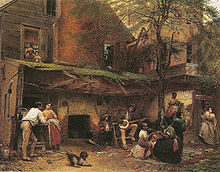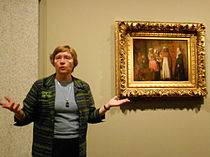User:Jake800AD/A Visit from the Old Mistress
| A Visit from the Old Mistress | |
|---|---|
 | |
| Artist | Winslow Homer |
| Year | 1876 |
| Medium | Oil on canvas |
| Dimensions | 45.7 cm × 61.0 cm (18 in × 24 in) |
| Condition | On display |
| Location | Smithsonian Museum of American Art, Washington, DC |
A Visit from the Old Mistress is an 1876 painting by the prominent 19th-century American artist Winslow Homer. It was one of several works which Homer had presumably created during a mid-1870s visit to Virginia, where he had served for a time as a Union war correspondent during the Civil War.[1] Scholars have noted that the painting's composition is taken from Homer's earlier painting Prisoners from the Front, which depicts a group of captive Confederate soldiers defiantly regarding a Union officer.[2] Put on display in the Northern States for a Northern audience, A Visit from the Old Mistress, along with Homer's other paintings of black southern life from the postbellum period, has been praised as an "invaluable record of an important segment of life in Virginia during the Reconstruction."[1]
General[edit]
Subject and Message[edit]
The painting shows three black women dressed in torn clothes on the left of the canvas, one of whom is sitting, one of whom is standing holding a black baby, and the third of whom is standing in the middle of the composition, facing an old white woman dressed in a widow's black (the titular Old Mistress) wearing a white lace collar, standing upright and looking evenly at the other subjects. The scene takes place in the cabin belonging to the black women, even though an alternate title of the piece would place it in the mistress's kitchen.[3] The intended tonality of the painting is debated by art historians, with earlier writers suggesting a level of "humor" inherent in the composition,[3] and later commentators insisting that the composition is either intended to relate a message of stubborn resistance on the part of the former slaves to their former mistress,[4][5] or to create an infantilized and harmless image of recently-emancipated blacks.[6]
Title and Background[edit]
While attached to the Union Army of the Potomac as a war correspondent, "Homer's attention had been strongly attracted to the negroes," which interest he renewed in 1877 after the conclusion of the Civil War, when he took a tour of post-bellum Virginia and created a string of works focused on primarily black subjects,[3] most famously his 1877 piece, Dressing for the Carnival, which came out only a year after A Visit. While "the only known reference to a southern trip was the one he made in 1877," nevertheless "the question of when and how often Homer revisited the South after the Civil War" is almost impossible to answer.[7] Whether he had been back to Virginia and had observed a scene like the one which he had put to canvas in A Visit, or if he had simply composed it from memories assembled during his time in the war, or by means of studio sets, is therefore "purely speculative."[2] Another scholarly opinion has it that Homer did, in fact, make earlier visits to Virginia in 1875 and 1876,[5][8] wherein he came to understand blacks not merely as "a humorous object," as they seem to be in some of his Civil War-era sketches, but as serious and fundamentally human subjects in art, paving the way for his much more serious compositions in the 70's.[5]
The original title, and the title used today, A Visit from the Old Mistress, has a double meaning. Whether the title is intended to mean, "a visit from the former mistress," (suggesting that the blacks are now free) or that the title should mean, "a visit from the mistress who is old," (suggesting that, despite their emancipation, the former slaves are still under the power of their mistress), is left unclear. The painting has also been catalogued under the titles, The Visit to the Mistress (implying that the scene takes place in the Mistress's manor) and The Visit of the Mistress (implying that the blacks in the painting remain under the power of their old mistress).[3]
Display and Ownership[edit]
The painting was initially purchased by Thomas B. Clarke, a private collector from New York, and changed hands again when he sold his collection in 1899, the painting being acquired by William T. Evans, who donated it to the National Gallery of Art in Washington D.C, where it was displayed under the title, The Visit of the Mistress.[3] From here, it eventually came into the hands of the Smithsonian American Art Museum, where it remains presently on display.[8]
A Visit from the Old Mistress was one of five paintings which Homer exhibited at the Paris universal exposition of 1878.[3]
Comparisons with Other Works[edit]
It has been pointed out in modern scholarship surrounding the piece that the composition of A Visit from the Old Mistress is nearly identical to that in Homer's earlier work, Prisoners from the Front, wherein a band of recently captured Confederate soldiers are shown standing defiantly in the face of their Union captor. This comparison has been used to suggest that there belongs to A Visit a similar confrontational attitude as is found in Prisoners, which would have it that the former slaves stand up (with one refusing even to do the dignity of standing), and boldly face their old mistress, who no longer wields the same sort of power over their lives.[5]
The interiors for both A Visit from the Old Mistress and Sunday Morning in Virginia were very likely composed simultaneously, "for they share a similar crude fireplace and plank door-way."[2]

The composition of the painting has also been compared with an earlier work by Eastman Johnson, titled, Negro Life at the South, or Old Kentucky Home, wherein an idyllic image of black Southern life is portrayed

Depiction of Black Subjects[edit]
The piece was initially received as being an example of Winslow Homer's recent shift towards realism in the depiction of black subjects, turning away from caricature. A contemporary critic wrote, "Mr. Homer is one of the few men who have been successful in painting the negro character without exaggerating or caricaturing it."[9]
Much modern critical commentary on the piece focuses on the twofold racial implications found within the work, both in the subject of the painting (a white woman, presumably a former slaveowner, standing with her former slaves), and in the very act of the composition of the work itself (Winslow Homer, a white Northerner, creating an image of black Southerners). Earlier commentators such as William Howe Downs, in his 1911 book, The Life and Works of Winslow Homer, comment that, "the three former slaves are observed and described most vividly and keenly. In their solemnity of demeanor, the humility of their expression, and the evident awe which the presence of the old mistress inspires, there is a blending of pathos and humor, which belongs to the situation, and is all the better for not having been injected into it."[3] This interpretation of the work, common among Homer's contemporaries, is understood as being fundamentally correct by some later commentators such as art historian Jo-Ann Morgan, who criticizes both this work and the works of Homer in general, writing that "Black men grew scarce in visual culture during reconstruction, and in that respect, Homer's paintings were not exceptions. His old mistress visited a fatherless home. In the chimney corner where Johnson in the 1860's seated a male figure, Homer in the 1870s placed females.... Representations of African-Americans as ragged women, dependent children, or aged old man have no potential to upset existing hierarchies of power."[6]
This understanding of the painting is challenged by other critics such as Sidney Kaplan, who describes the painting as depicting "a blonde, curled mistress" who expects "'friendship' from her former slaves, but the black matriarch, her great arms at her sides, stands like a cofferdam. She is scarcely a Jemima---not even a Faulknerian Dilsey. Her glance is rejection, a withering of the while delusion of her simplicity, while the eyes and mouths of her family shadow forth nuances of her dignity, scorn, and restraint."[5] In this view, the painting is neither a humorous scene, nor a manifestation of blatant white supremacy---rather, it embraces black identity, now freed from the bonds of slavery, and highlights both the "dignity" and independence of the black community, while the painting also "conveys a silent tension between two communities seeking to understand their future."[10]
"Homer let viewers feel good that slavery was ended, while assuring them that the plantation system persisted. Mapping distinctions in physiques--mistress aloof, ex-slaves slumped; dress--hers fine, theirs ragged; and site--the same old cabin; A Visit from the Old Mistress fixed in place a lateral hierarchy."[6]


| External videos | |
|---|---|
 | |
References[edit]
- ^ a b Wood, Peter; Dalton, Karen (1989). "Winslow Homer's images of Blacks: The Civil War and Reconstruction years". Virginia Museum of Fine Arts Bulletin. 49 (3). Virginia Museum of Fine Arts: 3–4.
- ^ a b c Calo, Mary Ann (1980). "Winslow Homer's Visits to Virginia during Reconstruction". American Art Journal. 12 (1). Kennedy Galleries Inc.: 4–27.
- ^ a b c d e f g Downes, William Howe (1911). The Life and Works of Winslow Homer. Houghton Mifflin.
- ^ Bindman, David; Gates Jr., Henry Louis (2019-05-17), "4. The New Negro", The Image of the Black in Western Art, Volume IV: From the American Revolution to World War I, Part 2: Black Models and White Myths, Harvard University Press, ISBN 978-0-300-24470-0, retrieved 2022-11-15
- ^ a b c d e Kaplan, Sidney (1966). "The Negro in the Art of Homer and Eakins". The Massachusetts Review. 7 (1): 105–120. ISSN 0025-4878.
- ^ a b c Morgan, Jo-Ann (2005). "Winslow Homer visits Aunt Chloe's Old Kentucky Home". Southeastern College Art Conference Review. 14 (5) – via Gale Academic Onefile.
- ^ Cikovsky, Nicolai; Kelly, Franklin; Walsh, Judith; Homer, Winslow; Art (U.S.), National Gallery of; Boston, Museum of Fine Arts (1995-01-01). Winslow Homer. Yale University Press. ISBN 978-0-300-06555-8.
- ^ a b "A Visit from the Old Mistress". Smithsonian Institution. Retrieved 2022-11-22.
- ^ Strix (24 April 1880). "Our Feuilleton. The Academy Exhibition". New York Evening Express.
- ^ "A Visit from the Old Mistress | Smithsonian American Art Museum". americanart.si.edu. Retrieved 2022-11-22.
- ^ "The Civil War and American Art, Episode 5". Smithsonian American Art Museum. Retrieved February 15, 2012.
